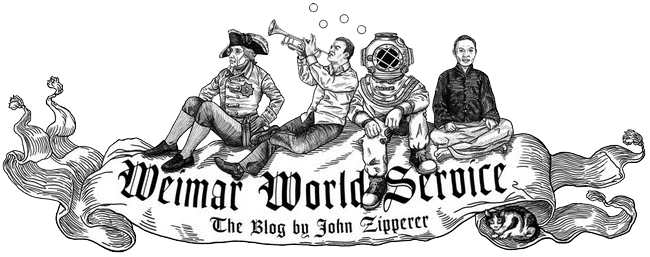 Setting aside for the moment all of the blowhard arguments about whether and how print magazines should adapt to the internet, the Wall Street Journal today has an interesting article about magazines that seem just a wee bit un-magaziney. For example: A magazine that comes in a sealed can each month, filled with various objects related to that month's topic. Or T-Post, a "multimedia magazine" that is really a t-shirt that bears a true story on the inside and an artist's interpretation of that story on the outside.
Setting aside for the moment all of the blowhard arguments about whether and how print magazines should adapt to the internet, the Wall Street Journal today has an interesting article about magazines that seem just a wee bit un-magaziney. For example: A magazine that comes in a sealed can each month, filled with various objects related to that month's topic. Or T-Post, a "multimedia magazine" that is really a t-shirt that bears a true story on the inside and an artist's interpretation of that story on the outside.And so on. The Journal's story wasn't necessarily an exhortation for all print magazines to follow those, er, leaders. It was more a report on some fringe artists who are stretching the boundaries of what can be called a magazine.
I won't try to play semanticist here. You can call a Ford Thunderbird a magazine if you want and it won't bother me. And while none of the magazines profiled in the Journal article in the least bit interest me as a potential reader (because, frankly, there doesn't seem to be much to read; it's art, not publishing), I do appreciate their willingness to rethink what can be done on an established model.
In less grandiose ways, smart magazines have long done things that went beyond the expectations of their readers. Anyone remember science fiction magazine Starlog including a pull-out modular kit to build a 3-D structure? British magazines, such as music mag Mojo, throw in lots of extras with magazines, including CDs and books. With magazines I've bought on newsstands or received via subscriptions over the years, I've received trading cards, VHS cassettes (for a British science fiction program, so it won't work on my old VCR), DVDs, posters, maps, blueprints, model kits, little action figures, free copies of other magazines, and of course books and CDs.
In general, these things are included to boost newsstand sales or to keep subscribers loyal. That's not quite the same as reinventing or reimagining the very concept of a magazine. But hey, it enlivens the sometimes mundane cycle of producing or consuming a periodical.

No comments:
Post a Comment